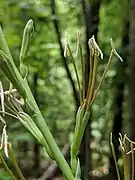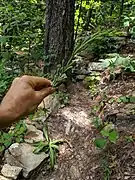Agave virginica
Agave virginica, synonym Manfreda virginica, commonly known as the false aloe, rattlesnake master, American aloe, and Virginia agave,[2][3][4] is a species of agave. It is native to an area stretching from North Carolina west to Texas in the United States and south to Nuevo León and Tamaulipas in Mexico.[2]
| Agave virginica | |
|---|---|
 | |
| Scientific classification | |
| Kingdom: | Plantae |
| Clade: | Tracheophytes |
| Clade: | Angiosperms |
| Clade: | Monocots |
| Order: | Asparagales |
| Family: | Asparagaceae |
| Subfamily: | Agavoideae |
| Genus: | Agave |
| Species: | A. virginica |
| Binomial name | |
| Agave virginica | |
| Synonyms[1] | |
|
List
| |
Description
False aloe is acaulescent, meaning the stem is extremely short. Leaves and flowering stems are from a bulbous herbaceous caudex. The fleshy green leaves are usually spotted or speckled with maroon. Sufficient precipitation yields an inflorescence up to 68 cm (27 in) tall in the period from early summer to late summer, rarely in the spring.
The inflorescences bears 10–61 closely spaced flowers. Flowers are sessile or pedicellate, nearly erect, slender, with a fragrant sweet fruity odor. Seed capsules are globose and 1–1.7 cm diameter.
Leaf shape and size in Agave virginica vary with soil type, amount of shade, length of cold period, and position of leaf in the rosette. Speckles and spots occur frequently on some leaves in most populations, and some authors have used the informal designation "forma tigrina" for such variants.[5]
Ecology
Agave virginica is adapted primarily to nocturnal pollination by medium-sized moths and larger sphinx moths. Diurnal pollination by large bees results in significantly less seed set than nocturnal and open pollination. Hummingbirds are also attracted to the blooms.[6]
Gallery
 Leaves
Leaves Flowers
Flowers Stem with flowers
Stem with flowers
References
- "Agave virginica", World Checklist of Selected Plant Families, Royal Botanic Gardens, Kew, retrieved 2019-04-14
- "Agave virginica". Germplasm Resources Information Network (GRIN). Agricultural Research Service (ARS), United States Department of Agriculture (USDA). Retrieved 21 January 2018.
- "Manfreda virginica (L.) Salisb. ex Rose". npgsweb.ars-grin.gov. Retrieved 29 October 2020.
- False Aloe, Missouri Department of Conservation, retrieved 2020-10-29
- "Manfreda virginica (Linnaeus) Salisbury ex Rose, Contr. U.S. Natl. Herb. 8: 19. 1903". Flora of North America. eFloras.org. Retrieved 2011-10-22.
- Groman, Joshua D.; Olle Pellmyr (1999). "The pollination biology of Manfreda virginica (Agavaceae); relative contributions of nocturnal and diurnal visitors". OIKOS. 87 (2): 373–381. doi:10.2307/3546753. JSTOR 3546753.